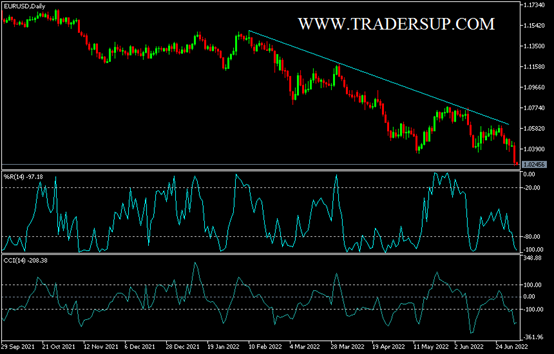The euro fell to its lowest level since 2002 against the dollar, and it is falling against the pound sterling and other major currencies. This comes amid a sharp deterioration in investor sentiment towards the euro zone as gas prices rose after recent reports of the closure of a major gas pipeline transit. Accordingly, the EUR/USD pair moved towards the 1.0235 support level, which is stable around it at the time of writing the analysis.
The Euro was sold off strongly. The drop in the euro against the dollar means that some banks are now charging below par for some international payments. London remains the largest forex trading center in the world, and big moves in forex often happen when the market opens. The sale of the single European currency comes amid rising gas prices in Europe with fears that Germany will be particularly exposed, given its unhelpful source of energy production: France has large nuclear capacity, and Germany is shutting down its nuclear power plants.
The headlines ahead of yesterday’s London opening confirmed that European gas imports have shrunk further with the Yamal-Europe pipeline being shut down. The data showed that the German gas transporter Gaskid said that exit flows at the Malno measuring point on the German border fell to zero after it flowed earlier at 2190136 kWh.
For its part, the International Energy Agency says in its latest gas market review, that the share of Russian gas (including LNG) meeting total EU demand increased from 30% in 2009 to 47% in 2019. The report adds that the strong flow of gas LNG in 2020, amid increased global supply, reduced the share of Russian gas to about 40%, adding that it remained at a similar level in 2021, driven by Gazprom’s strategy of reducing short-term sales to the bloc. Despite the availability of excess supply capacity and the possibility of achieving high returns in the export markets.
This strategy appears to be working again: Yamal’s shutdown comes a day after gas prices rose on news of an industrial strike at Norwegian gas fields. At the moment, this appears to be a Euro-specific problem since the market has not penalized the GBP to the same degree. The UK is also facing a slight rise in gas prices, but it should be noted that for some time the foreign exchange markets have been trading the narrative that the UK is the biggest victim of this energy crisis. And it is close to the price of the pound now.
Adding some pro-sterling sentiment was the top revision of final June PMI data for the UK, according to the tabulated data release by S&P Global. This confirms how sentiment towards the EUR currently appears to be shifting among investors. Commenting on this, Ulrich Leuchtmann, Head of Foreign Exchange and Commodity Research at Commerzbank, said: “The gas supply crisis will be a Europe-specific problem. And if things go that bad, it will only affect Europe, it will only affect the monetary policy of the European Central Bank, and therefore it will be a reason for the characteristic weakness of the euro.”
Meanwhile, money markets are showing a rapid reassessment of the number of interest rate increases that the European Central Bank will introduce over the coming months. As a result, German 10-year bond yields fell sharply amid this recalibration. The lower yields automatically pull support away from the Euro as investors look for better returns in other markets.
Eurozone bond yields rose sharply during the spring period as the European Central Bank made a “hardcore” shift in guidance and confirmed that it would raise interest rates in July and then again in September. This has been proven to support the euro exchange rates. However, given the magnitude of the pressures facing the Eurozone economy, the market is betting that the first rally will be 25bp rather than 50. The total number of hikes that the ECB will be able to deliver is also dropping. Accordingly, the euro could reach the dollar to 1.02 as the trade deficit increases.
The Eurozone’s new trade deficit with the rest of the world is one reason to expect further weak performance in the Euro, according to currency analysts.
Where is the Euro 2022 heading after the recent losses?
After the recent losses of the EUR/USD currency pair, speculations increased that the price of the most popular currency pair in the currency market might move towards the parity price once the support level 1.0200 is breached. Taking into consideration that the recent losses pushed the technical indicators towards strong oversold levels. But the factors for the US dollar’s gains are still the strongest, and the euro lacks the momentum to stop the pace of its losses. On the other hand, and according to the performance on the daily chart below, the bulls need to breach the 1.0620 and 1.0800 resistance levels to make a change in the current general bearish trend. The currency pair will react strongly today with the announcement of the contents of the latest meeting minutes of the US Federal Reserve.


